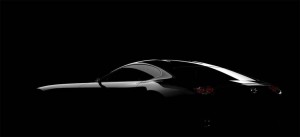Is Mazda finally ready to relaunch its RX sports car? It’s certainly starting to look like the answer is “yes.”
With barely a month to go before the biennial Tokyo Motor Show opens, the Japanese maker is offering a few hints of what it will have on display. And among the 14 models that will be on the stand, we can expect a sports car concept that, says Mazda, “maintains a sense of lineage and authenticity.”
Of course, if Mazda is truly set to reach back in its historical back of tricks, that raises another critical question: will the new sports car pack an updated version of Mazda’s signature rotary under the hood? Company officials have offered broad hints that they’re working on a Wankel engine that can meet modern fuel economy and emissions requirements.
The rotary was a central part of the successful formula when Mazda introduced the original RX-7 sports car back in 1978. It remained the throbbing heart of successive generations of RX-7s through 2002, Mazda eventually building more than 800,000 of the sports cars. And the rotary returned in 2003 when the quirky, four-door RX-8 was launched. But declining sales led Mazda to wrap up production in 2012.
Ever since, rumors have repeatedly hinted at Mazda’s plans to revive both the rotary and the RX sports car line. The teaser image shown here is the first official indication from Mazda that something really is under development.
“The design of the sports car concept to be unveiled in Tokyo is modern but maintains a sense of lineage and authenticity,” said a statement accompany the release, “appearing almost to condense Mazda’s entire history of sports car development into a single model.”
(Click Here for a review of the all-new Mazda Miata.)
Squint your eyes and you might, indeed, catch some of the design cues found on various Mazda RX models over the decades. There’s the long, aggressive hood and the sweeping curve of the roofline. But the concept does not appear to be a retro-mobile. The flowing lines of the roof, which appear to taper inward, are a very modern interpretation.
The taillamps are small and all but certain to use LED lighting. Though this may be a hatchback, there appears to be a modest-sized rear deck, and the way the lines flow hint at the possibility of some active aero elements, perhaps the sort of pop-up spoiler found on a variety of European sports cars.
The sports car concept will share space with Mazda’s Koeru design concept which made its own debut at the Frankfurt Motor Show this month. While the Koeru is believed to be a thinly disguised version of the next Mazda CX-7 or CX-9 crossover, one can expect to see some of its styling cues carry over onto the skin of the Mazda sports car concept.
“The Koeru expresses the power and vitality of a predator along with a unique level of refined dignity,” Mazda said of the Frankfurt show car – language that would seem better suited to a sports car than a sport-ute.
(Click Here to check out the Mazda Koeru concept.)
The new teaser image leaves plenty of questions unanswered. Among them: what platform would the production model use? Mazda developed an all-new architecture for the 2016 MX-5 Miata, but that roadster is all but certainly smaller than the sports car. How much flexibility Mazda has to stretch it is unclear.
As for the rotary engine, TheDetroitBureau.com reported last November that Mazda has two projects on the table — one for 2017 and another for 2020 – but it appears they will both revolve around the same rotary model, the reveal and launch of which will be spread over a four-year period.
(Mazda lands two contenders on the Short List for North American Car, Truck of the Year. Click Here for the full list.)
“We want to surprise everyone in 2017 with something special to celebrate the birth of rotary,” a senior Mazda executive told us. “Then, to celebrate the company’s 100th birthday, we want to take it to another level in 2020,” he added, confirming separate celebrations for both anniversaries.
If that timetable still holds, it would seem to fit perfectly for a rotary-powered sports car based on the Tokyo concept.
The challenges for the Wankel have been many, most notably the need to slash emissions and to boost fuel economy – something that kept the once-promising Wankel out of the mass market. Mazda insiders promise that they’ve been able to make major improvements in recent years that could make the rotary viable again, at least in this limited application.
We should find out in barely a month’s time.


The return of the RX Model would certainly be a welcome one.